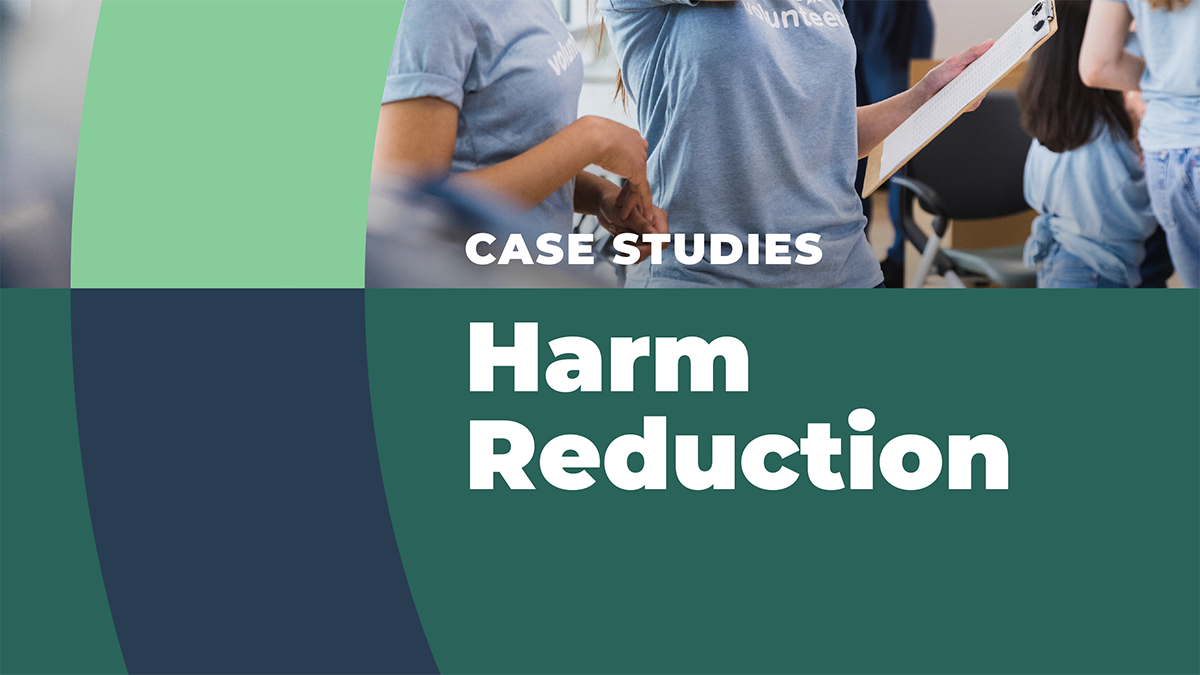At a glance
Read about how harm reduction works to reduce drug overdose from a case study from Overdose Data to Action in Illinois.

How can harm reduction work to reduce drug overdose?
Case Studies: Harm Reduction - Full Report
Harm reduction is a public health approach that focuses on mitigating the harmful consequences of drug use, including transmission of infectious disease and prevention of overdose, through provision of care that is intended to be free of stigma and centered on the needs of people who use drugs.1 Harm reduction programs are often managed by community or peer-led organizations, or health departments. Harm reduction activities can include provision of sterile syringes, naloxone distribution, fentanyl testing, overdose prevention and education, including safer drug use education, and other activities that can lessen the risk of adverse outcomes associated with using drugs. For example, syringe services programs (SSPs) can reduce the occurrence of HIV and hepatitis C.2 These programs improve public safety through safe needle provision and disposal and are not associated with an increase in crime.34 SSPs educate clients and community members about safer drug use, which may include information about how to recognize and reverse an opioid-involved overdose using naloxone.5 Harm reduction programs also offer critical linkages to treatment for substance use disorders (SUDs) and other resources for populations with less access to care.1 CDC's Evidence-Based Strategies for Preventing Opioid Overdose resource includes linkage to care and harm reduction strategies such as SSPs and targeted naloxone distribution, and harm reduction is a priority area for the HHS Overdose Prevention Strategy.
Case study snapshot
Harm Reduction Community Linkage Project – Illinois
- The Illinois Department of Public Health (IDPH) funds five harm reduction organizations and two county health departments in seven regions of the state with the highest opioid overdose death counts. The project may expand into regions with lower overdose death counts that lack support for harm reduction programs.
- The Harm Reduction Community Linkage Project (HRCLP) aims to:
- Build the capacity of harm reduction organizations statewide.
- Increase awareness of the role of harm reduction in overdose prevention and response.
- Improve coordination between the harm reduction community and SUD treatment providers.
- Connect people to SUD treatment and support services.
- Provide case management.
- Build the capacity of harm reduction organizations statewide.
- A state-level coordinator facilitates connections among the funded sites and seven local harm reduction coordinators. Coordinators determine needs through routine interviews with harm reduction clients, work with advisory boards of people who use drugs, and through the use of IDPH surveillance data.
- Key partners include healthcare and SUD treatment providers, local harm reduction advocates, law enforcement, nonprofit organizations, and community members including those who currently use substances or seek support services.
For more information about Illinois' Harm Reduction Community Linkage Project, check out full report in Case Studies: Harm Reduction.
- Hawk, K. F., Vaca, F. E., & D'Onofrio, G. (2015). Reducing Fatal Opioid Overdose: Prevention, Treatment and Harm Reduction Strategies. The Yale Journal of Biology and Medicine, 88(3), 235–245.
- Platt, L., Minozzi, S., Reed, J., Vickerman, P., Hagan, H., French, C., Jordan, A., Degenhardt, L., Hope, V., Hutchinson, S., Maher, L., Palmateer, N., Taylor, A., Bruneau, J., & Hickman, M. (2017) Needle syringe programmes and opioid substitution therapy for preventing hepatitis C transmission in people who inject drugs. Cochrane Database of Systematic Reviews, 9(9), 1-80. https://doi.org/10.1002/14651858.CD012021.pub2
- Tookes, H. E., Kral, A. H., Wenger, L. D., Cardenas, G. A., Martinez, A. N., Sherman, R. L., Pereyra, M., Forrest, D. W., LaLota, M., & Metsch, L. R. (2012). A comparison of syringe disposal practices among injection drug users in a city with versus a city without needle and syringe programs. Drug and Alcohol Dependence, 123(1-3), 255-259. https://doi.org/10.1016/j.drugalcdep.2011.12.001
- Marx, M. A., Crape, B., Brookmeyer, R. S., Junge, B., Latkin, C., Vlahov, D., & Strathdee, S. A. (2000). Trends in crime and the introduction of a needle exchange program. American Journal of Public Health, 90(12), 1933-1936. https://doi.org/10.2105/ajph.90.12.1933
- Tobin, K. E., Sherman, S. G., Beilenson, P., Welsh, C., & Latkin, C. A. (2009). Evaluation of the Staying Alive programme: Training injection drug users to properly administer naloxone and save lives. The International Journal of Drug Policy, 20(2), 131-136. https://doi.org/10.1016/j.drugpo.2008.03.002
